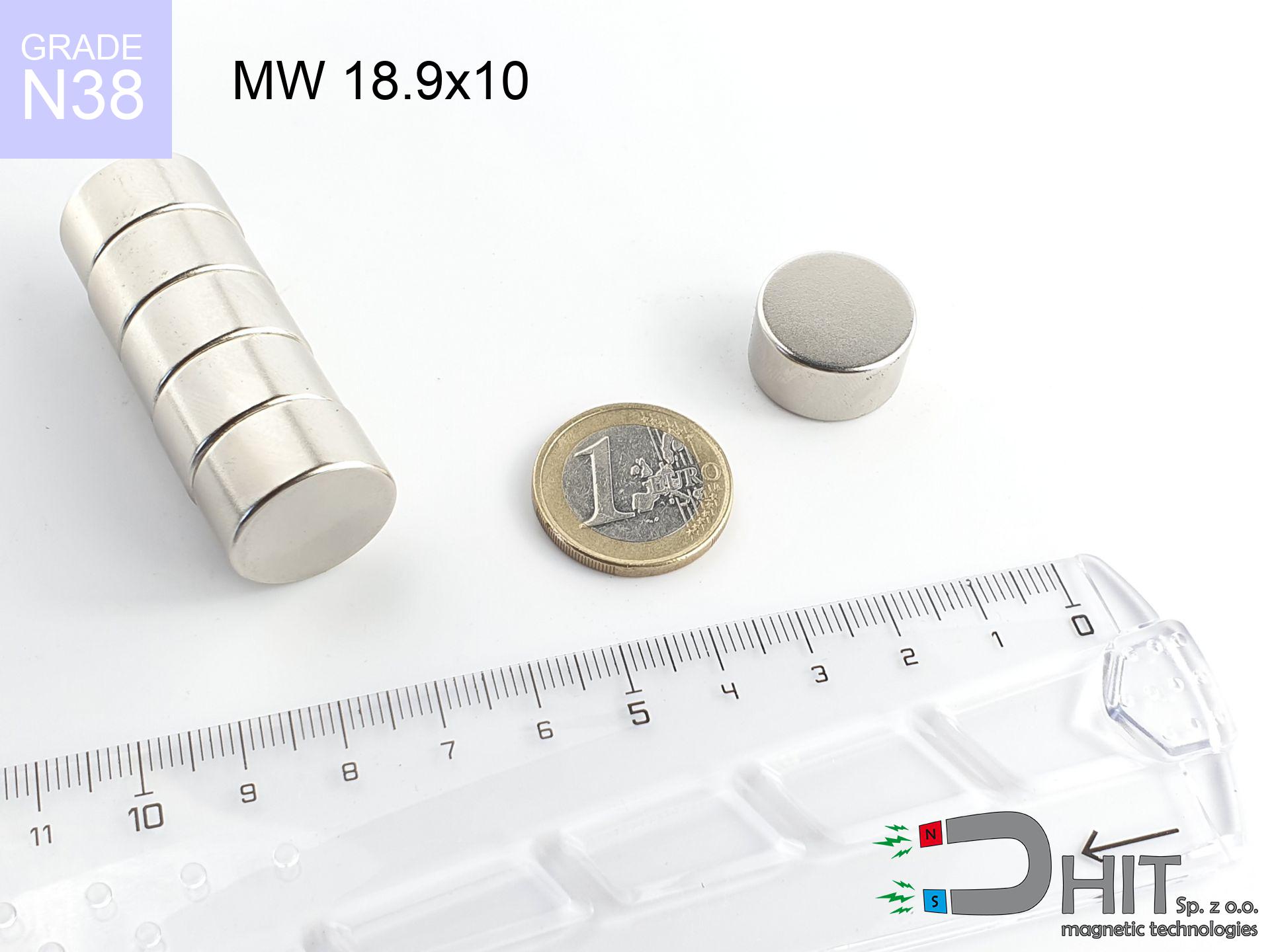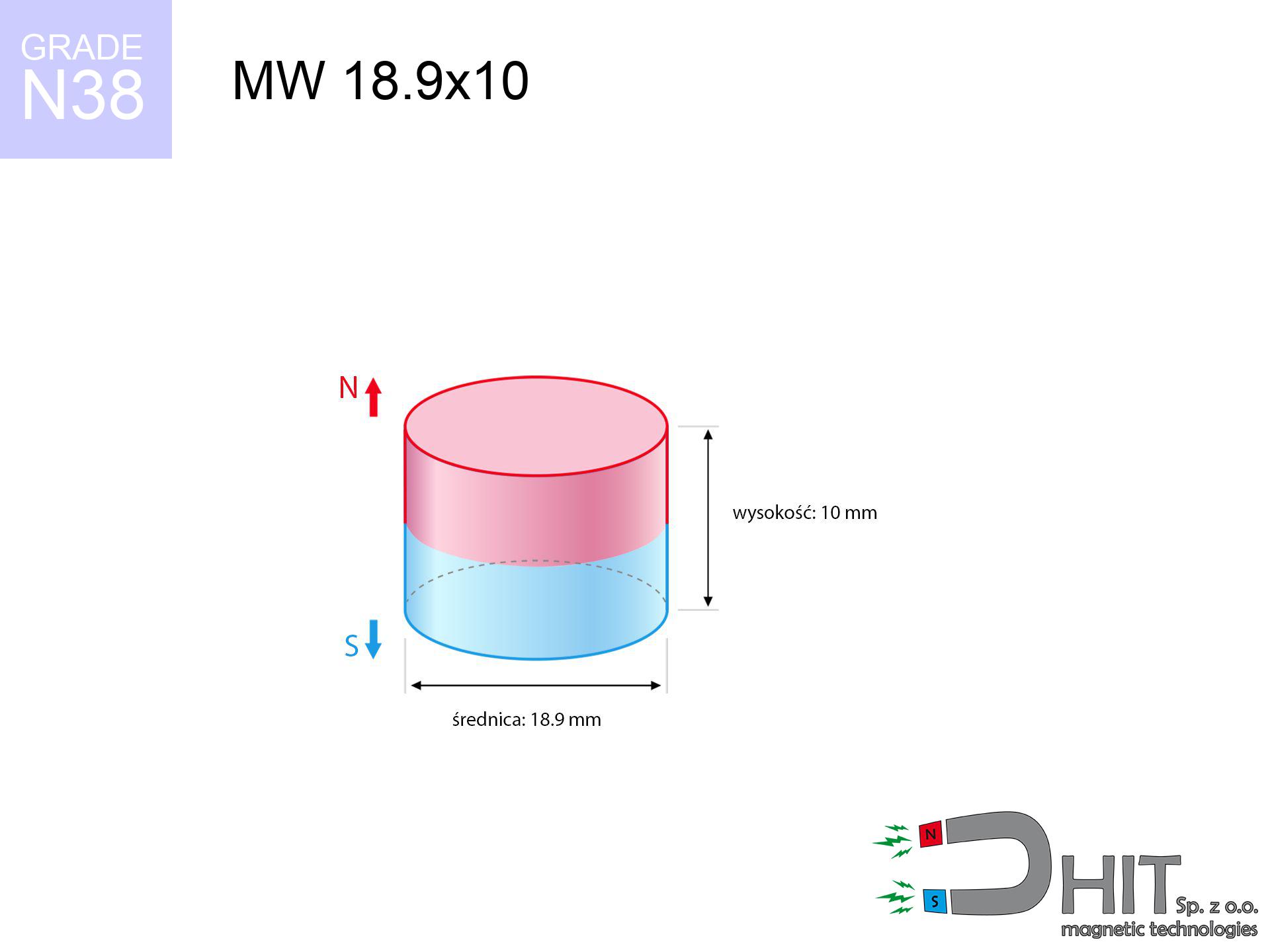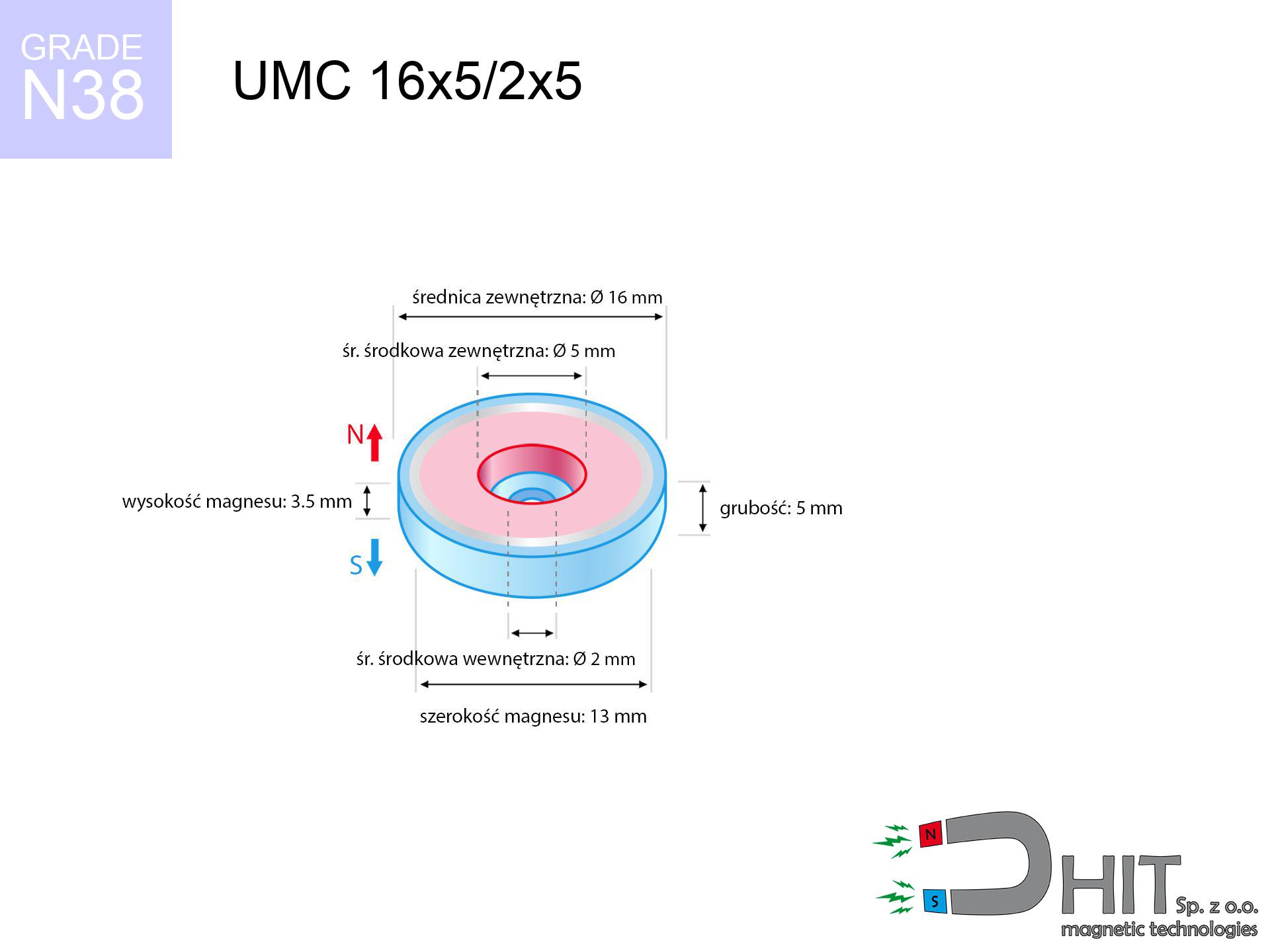MW 18.9x10 / N38 - cylindrical magnet
cylindrical magnet
Catalog no 010036
GTIN/EAN: 5906301810353
Diameter Ø
18.9 mm [±0,1 mm]
Height
10 mm [±0,1 mm]
Weight
21.04 g
Magnetization Direction
→ diametrical
Load capacity
11.68 kg / 114.54 N
Magnetic Induction
450.35 mT / 4503 Gs
Coating
[NiCuNi] Nickel
11.07 ZŁ with VAT / pcs + price for transport
9.00 ZŁ net + 23% VAT / pcs
bulk discounts:
Need more?
Pick up the phone and ask
+48 22 499 98 98
if you prefer contact us through
our online form
the contact page.
Lifting power as well as structure of neodymium magnets can be tested using our
our magnetic calculator.
Same-day processing for orders placed before 14:00.
Technical specification of the product - MW 18.9x10 / N38 - cylindrical magnet
Specification / characteristics - MW 18.9x10 / N38 - cylindrical magnet
| properties | values |
|---|---|
| Cat. no. | 010036 |
| GTIN/EAN | 5906301810353 |
| Production/Distribution | Dhit sp. z o.o. |
| Country of origin | Poland / China / Germany |
| Customs code | 85059029 |
| Diameter Ø | 18.9 mm [±0,1 mm] |
| Height | 10 mm [±0,1 mm] |
| Weight | 21.04 g |
| Magnetization Direction | → diametrical |
| Load capacity ~ ? | 11.68 kg / 114.54 N |
| Magnetic Induction ~ ? | 450.35 mT / 4503 Gs |
| Coating | [NiCuNi] Nickel |
| Manufacturing Tolerance | ±0.1 mm |
Magnetic properties of material N38
| properties | values | units |
|---|---|---|
| remenance Br [min. - max.] ? | 12.2-12.6 | kGs |
| remenance Br [min. - max.] ? | 1220-1260 | mT |
| coercivity bHc ? | 10.8-11.5 | kOe |
| coercivity bHc ? | 860-915 | kA/m |
| actual internal force iHc | ≥ 12 | kOe |
| actual internal force iHc | ≥ 955 | kA/m |
| energy density [min. - max.] ? | 36-38 | BH max MGOe |
| energy density [min. - max.] ? | 287-303 | BH max KJ/m |
| max. temperature ? | ≤ 80 | °C |
Physical properties of sintered neodymium magnets Nd2Fe14B at 20°C
| properties | values | units |
|---|---|---|
| Vickers hardness | ≥550 | Hv |
| Density | ≥7.4 | g/cm3 |
| Curie Temperature TC | 312 - 380 | °C |
| Curie Temperature TF | 593 - 716 | °F |
| Specific resistance | 150 | μΩ⋅cm |
| Bending strength | 250 | MPa |
| Compressive strength | 1000~1100 | MPa |
| Thermal expansion parallel (∥) to orientation (M) | (3-4) x 10-6 | °C-1 |
| Thermal expansion perpendicular (⊥) to orientation (M) | -(1-3) x 10-6 | °C-1 |
| Young's modulus | 1.7 x 104 | kg/mm² |
Engineering simulation of the product - data
These values are the outcome of a physical simulation. Results are based on algorithms for the class Nd2Fe14B. Real-world parameters might slightly differ. Treat these calculations as a reference point when designing systems.
Table 1: Static force (pull vs gap) - power drop
MW 18.9x10 / N38
| Distance (mm) | Induction (Gauss) / mT | Pull Force (kg) | Risk Status |
|---|---|---|---|
| 0 mm |
4502 Gs
450.2 mT
|
11.68 kg / 11680.0 g
114.6 N
|
crushing |
| 1 mm |
4050 Gs
405.0 mT
|
9.46 kg / 9455.2 g
92.8 N
|
warning |
| 2 mm |
3587 Gs
358.7 mT
|
7.42 kg / 7416.3 g
72.8 N
|
warning |
| 3 mm |
3139 Gs
313.9 mT
|
5.68 kg / 5678.8 g
55.7 N
|
warning |
| 5 mm |
2346 Gs
234.6 mT
|
3.17 kg / 3172.5 g
31.1 N
|
warning |
| 10 mm |
1100 Gs
110.0 mT
|
0.70 kg / 696.7 g
6.8 N
|
weak grip |
| 15 mm |
554 Gs
55.4 mT
|
0.18 kg / 176.7 g
1.7 N
|
weak grip |
| 20 mm |
308 Gs
30.8 mT
|
0.05 kg / 54.6 g
0.5 N
|
weak grip |
| 30 mm |
120 Gs
12.0 mT
|
0.01 kg / 8.3 g
0.1 N
|
weak grip |
| 50 mm |
32 Gs
3.2 mT
|
0.00 kg / 0.6 g
0.0 N
|
weak grip |
Table 2: Vertical hold (vertical surface)
MW 18.9x10 / N38
| Distance (mm) | Friction coefficient | Pull Force (kg) |
|---|---|---|
| 0 mm | Stal (~0.2) |
2.34 kg / 2336.0 g
22.9 N
|
| 1 mm | Stal (~0.2) |
1.89 kg / 1892.0 g
18.6 N
|
| 2 mm | Stal (~0.2) |
1.48 kg / 1484.0 g
14.6 N
|
| 3 mm | Stal (~0.2) |
1.14 kg / 1136.0 g
11.1 N
|
| 5 mm | Stal (~0.2) |
0.63 kg / 634.0 g
6.2 N
|
| 10 mm | Stal (~0.2) |
0.14 kg / 140.0 g
1.4 N
|
| 15 mm | Stal (~0.2) |
0.04 kg / 36.0 g
0.4 N
|
| 20 mm | Stal (~0.2) |
0.01 kg / 10.0 g
0.1 N
|
| 30 mm | Stal (~0.2) |
0.00 kg / 2.0 g
0.0 N
|
| 50 mm | Stal (~0.2) |
0.00 kg / 0.0 g
0.0 N
|
Table 3: Wall mounting (sliding) - behavior on slippery surfaces
MW 18.9x10 / N38
| Surface type | Friction coefficient / % Mocy | Max load (kg) |
|---|---|---|
| Raw steel |
µ = 0.3
30% Nominalnej Siły
|
3.50 kg / 3504.0 g
34.4 N
|
| Painted steel (standard) |
µ = 0.2
20% Nominalnej Siły
|
2.34 kg / 2336.0 g
22.9 N
|
| Oily/slippery steel |
µ = 0.1
10% Nominalnej Siły
|
1.17 kg / 1168.0 g
11.5 N
|
| Magnet with anti-slip rubber |
µ = 0.5
50% Nominalnej Siły
|
5.84 kg / 5840.0 g
57.3 N
|
Table 4: Material efficiency (saturation) - power losses
MW 18.9x10 / N38
| Steel thickness (mm) | % power | Real pull force (kg) |
|---|---|---|
| 0.5 mm |
|
0.58 kg / 584.0 g
5.7 N
|
| 1 mm |
|
1.46 kg / 1460.0 g
14.3 N
|
| 2 mm |
|
2.92 kg / 2920.0 g
28.6 N
|
| 5 mm |
|
7.30 kg / 7300.0 g
71.6 N
|
| 10 mm |
|
11.68 kg / 11680.0 g
114.6 N
|
Table 5: Thermal resistance (stability) - power drop
MW 18.9x10 / N38
| Ambient temp. (°C) | Power loss | Remaining pull | Status |
|---|---|---|---|
| 20 °C | 0.0% |
11.68 kg / 11680.0 g
114.6 N
|
OK |
| 40 °C | -2.2% |
11.42 kg / 11423.0 g
112.1 N
|
OK |
| 60 °C | -4.4% |
11.17 kg / 11166.1 g
109.5 N
|
OK |
| 80 °C | -6.6% |
10.91 kg / 10909.1 g
107.0 N
|
|
| 100 °C | -28.8% |
8.32 kg / 8316.2 g
81.6 N
|
Table 6: Magnet-Magnet interaction (repulsion) - forces in the system
MW 18.9x10 / N38
| Gap (mm) | Attraction (kg) (N-S) | Repulsion (kg) (N-N) |
|---|---|---|
| 0 mm |
35.05 kg / 35053 g
343.9 N
5 600 Gs
|
N/A |
| 1 mm |
31.70 kg / 31696 g
310.9 N
8 562 Gs
|
28.53 kg / 28527 g
279.8 N
~0 Gs
|
| 2 mm |
28.38 kg / 28376 g
278.4 N
8 101 Gs
|
25.54 kg / 25538 g
250.5 N
~0 Gs
|
| 3 mm |
25.22 kg / 25216 g
247.4 N
7 636 Gs
|
22.69 kg / 22694 g
222.6 N
~0 Gs
|
| 5 mm |
19.53 kg / 19527 g
191.6 N
6 720 Gs
|
17.57 kg / 17575 g
172.4 N
~0 Gs
|
| 10 mm |
9.52 kg / 9521 g
93.4 N
4 692 Gs
|
8.57 kg / 8569 g
84.1 N
~0 Gs
|
| 20 mm |
2.09 kg / 2091 g
20.5 N
2 199 Gs
|
1.88 kg / 1882 g
18.5 N
~0 Gs
|
| 50 mm |
0.06 kg / 60 g
0.6 N
372 Gs
|
0.05 kg / 54 g
0.5 N
~0 Gs
|
Table 7: Protective zones (electronics) - warnings
MW 18.9x10 / N38
| Object / Device | Limit (Gauss) / mT | Safe distance |
|---|---|---|
| Pacemaker | 5 Gs (0.5 mT) | 10.0 cm |
| Hearing aid | 10 Gs (1.0 mT) | 8.0 cm |
| Mechanical watch | 20 Gs (2.0 mT) | 6.0 cm |
| Mobile device | 40 Gs (4.0 mT) | 5.0 cm |
| Remote | 50 Gs (5.0 mT) | 4.5 cm |
| Payment card | 400 Gs (40.0 mT) | 2.0 cm |
| HDD hard drive | 600 Gs (60.0 mT) | 1.5 cm |
Table 8: Impact energy (kinetic energy) - collision effects
MW 18.9x10 / N38
| Start from (mm) | Speed (km/h) | Energy (J) | Predicted outcome |
|---|---|---|---|
| 10 mm |
24.63 km/h
(6.84 m/s)
|
0.49 J | |
| 30 mm |
41.18 km/h
(11.44 m/s)
|
1.38 J | |
| 50 mm |
53.13 km/h
(14.76 m/s)
|
2.29 J | |
| 100 mm |
75.14 km/h
(20.87 m/s)
|
4.58 J |
Table 9: Corrosion resistance
MW 18.9x10 / N38
| Technical parameter | Value / Description |
|---|---|
| Coating type | [NiCuNi] Nickel |
| Layer structure | Nickel - Copper - Nickel |
| Layer thickness | 10-20 µm |
| Salt spray test (SST) ? | 24 h |
| Recommended environment | Indoors only (dry) |
Table 10: Electrical data (Flux)
MW 18.9x10 / N38
| Parameter | Value | SI Unit / Description |
|---|---|---|
| Magnetic Flux | 12 775 Mx | 127.7 µWb |
| Pc Coefficient | 0.61 | High (Stable) |
Table 11: Submerged application
MW 18.9x10 / N38
| Environment | Effective steel pull | Effect |
|---|---|---|
| Air (land) | 11.68 kg | Standard |
| Water (riverbed) |
13.37 kg
(+1.69 kg Buoyancy gain)
|
+14.5% |
1. Sliding resistance
*Note: On a vertical surface, the magnet retains only approx. 20-30% of its perpendicular strength.
2. Plate thickness effect
*Thin metal sheet (e.g. 0.5mm PC case) severely reduces the holding force.
3. Thermal stability
*For N38 grade, the max working temp is 80°C.
4. Demagnetization curve and operating point (B-H)
chart generated for the permeance coefficient Pc (Permeance Coefficient) = 0.61
This simulation demonstrates the magnetic stability of the selected magnet under specific geometric conditions. The solid red line represents the demagnetization curve (material potential), while the dashed blue line is the load line based on the magnet's geometry. The Pc (Permeance Coefficient), also known as the load line slope, is a dimensionless value that describes the relationship between the magnet's shape and its magnetic stability. The intersection of these two lines (the black dot) is the operating point — it determines the actual magnetic flux density generated by the magnet in this specific configuration. A higher Pc value means the magnet is more 'slender' (tall relative to its area), resulting in a higher operating point and better resistance to irreversible demagnetization caused by external fields or temperature. A value of 0.42 is relatively low (typical for flat magnets), meaning the operating point is closer to the 'knee' of the curve — caution is advised when operating at temperatures near the maximum limit to avoid strength loss.
Material specification
| iron (Fe) | 64% – 68% |
| neodymium (Nd) | 29% – 32% |
| boron (B) | 1.1% – 1.2% |
| dysprosium (Dy) | 0.5% – 2.0% |
| coating (Ni-Cu-Ni) | < 0.05% |
Sustainability
| recyclability (EoL) | 100% |
| recycled raw materials | ~10% (pre-cons) |
| carbon footprint | low / zredukowany |
| waste code (EWC) | 16 02 16 |
See more products
Strengths and weaknesses of Nd2Fe14B magnets.
Advantages
- They virtually do not lose strength, because even after 10 years the decline in efficiency is only ~1% (based on calculations),
- They maintain their magnetic properties even under close interference source,
- A magnet with a smooth nickel surface has an effective appearance,
- Magnetic induction on the working layer of the magnet turns out to be maximum,
- Due to their durability and thermal resistance, neodymium magnets can operate (depending on the form) even at high temperatures reaching 230°C or more...
- Possibility of detailed modeling and adjusting to individual applications,
- Key role in innovative solutions – they find application in mass storage devices, electromotive mechanisms, diagnostic systems, also multitasking production systems.
- Relatively small size with high pulling force – neodymium magnets offer high power in compact dimensions, which enables their usage in miniature devices
Weaknesses
- Brittleness is one of their disadvantages. Upon intense impact they can fracture. We recommend keeping them in a special holder, which not only secures them against impacts but also increases their durability
- Neodymium magnets decrease their power under the influence of heating. As soon as 80°C is exceeded, many of them start losing their force. Therefore, we recommend our special magnets marked [AH], which maintain stability even at temperatures up to 230°C
- Magnets exposed to a humid environment can corrode. Therefore during using outdoors, we suggest using water-impermeable magnets made of rubber, plastic or other material protecting against moisture
- Limited ability of making threads in the magnet and complicated forms - preferred is a housing - magnet mounting.
- Health risk related to microscopic parts of magnets can be dangerous, if swallowed, which becomes key in the context of child safety. It is also worth noting that tiny parts of these magnets are able to complicate diagnosis medical after entering the body.
- High unit price – neodymium magnets have a higher price than other types of magnets (e.g. ferrite), which can limit application in large quantities
Holding force characteristics
Maximum holding power of the magnet – what contributes to it?
- with the use of a sheet made of special test steel, guaranteeing full magnetic saturation
- with a thickness minimum 10 mm
- characterized by even structure
- with zero gap (without impurities)
- under axial application of breakaway force (90-degree angle)
- at temperature room level
Lifting capacity in real conditions – factors
- Distance – existence of foreign body (rust, tape, gap) interrupts the magnetic circuit, which lowers capacity rapidly (even by 50% at 0.5 mm).
- Loading method – catalog parameter refers to detachment vertically. When slipping, the magnet exhibits significantly lower power (typically approx. 20-30% of maximum force).
- Element thickness – for full efficiency, the steel must be adequately massive. Paper-thin metal limits the lifting capacity (the magnet "punches through" it).
- Steel type – low-carbon steel attracts best. Alloy admixtures lower magnetic permeability and holding force.
- Base smoothness – the smoother and more polished the surface, the larger the contact zone and higher the lifting capacity. Unevenness creates an air distance.
- Thermal factor – hot environment weakens magnetic field. Exceeding the limit temperature can permanently demagnetize the magnet.
Lifting capacity testing was performed on a smooth plate of optimal thickness, under perpendicular forces, however under shearing force the load capacity is reduced by as much as 75%. Moreover, even a slight gap between the magnet’s surface and the plate decreases the holding force.
Warnings
Handling rules
Before starting, check safety instructions. Uncontrolled attraction can destroy the magnet or hurt your hand. Be predictive.
Fire risk
Machining of NdFeB material carries a risk of fire hazard. Neodymium dust oxidizes rapidly with oxygen and is hard to extinguish.
Precision electronics
Remember: neodymium magnets produce a field that disrupts precision electronics. Keep a safe distance from your phone, tablet, and navigation systems.
Magnets are brittle
Protect your eyes. Magnets can explode upon uncontrolled impact, ejecting shards into the air. Eye protection is mandatory.
Data carriers
Very strong magnetic fields can corrupt files on credit cards, hard drives, and other magnetic media. Stay away of min. 10 cm.
Medical implants
Individuals with a ICD have to maintain an safe separation from magnets. The magnetism can interfere with the functioning of the implant.
Bone fractures
Big blocks can crush fingers instantly. Do not place your hand between two attracting surfaces.
Demagnetization risk
Regular neodymium magnets (grade N) undergo demagnetization when the temperature exceeds 80°C. This process is irreversible.
This is not a toy
Product intended for adults. Tiny parts can be swallowed, leading to intestinal necrosis. Keep out of reach of children and animals.
Allergic reactions
It is widely known that nickel (the usual finish) is a strong allergen. For allergy sufferers, prevent direct skin contact or choose encased magnets.




![UMGGZ 22x6 [M4] GZ / N38 - rubber magnetic holder external thread UMGGZ 22x6 [M4] GZ / N38 - rubber magnetic holder external thread](https://cdn3.dhit.pl/graphics/products/umg-22x6-m4-gz-hiw.jpg)
![SM 32x400 [2xM8] / N42 - magnetic separator SM 32x400 [2xM8] / N42 - magnetic separator](https://cdn3.dhit.pl/graphics/products/sm-32x400-2xm8-tep.jpg)



